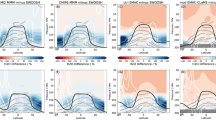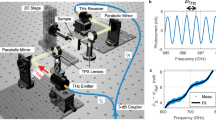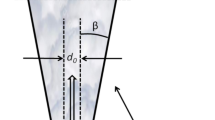Abstract
A PRELIMINARY experiment has been carried out to investigate the feasibility of making submillimetre wave measurements from a jet aircraft flying in the stratosphere. The value of such aircraft as observation platforms is that very low values of water vapour content in the line of sight can be obtained and water vapour is the dominant atmospheric absorber at submillimetre wavelengths. In this sense the experiments can be regarded to continue those made at high altitude observatories1,2, but to improve on them greatly because it was possible to determine lower total water values.
This is a preview of subscription content, access via your institution
Access options
Subscribe to this journal
Receive 51 print issues and online access
$199.00 per year
only $3.90 per issue
Buy this article
- Purchase on SpringerLink
- Instant access to full article PDF
Prices may be subject to local taxes which are calculated during checkout
Similar content being viewed by others
References
Gebbie, H. A., Phys. Rev., 109, 1174 (1957).
Farmer, C. B., and Key, P. J., App. Opt., 4, 1051 (1965).
Author information
Authors and Affiliations
Rights and permissions
About this article
Cite this article
BATER, M., CAMERON, R., BURROUGHS, W. et al. Submillimetre Wave Observations at an Altitude of 40,000 ft.. Nature 214, 377 (1967). https://doi.org/10.1038/214377a0
Received:
Issue date:
DOI: https://doi.org/10.1038/214377a0
This article is cited by
-
Observations of Far Infrared Atmospheric Windows at 44 cm−1 and 50 cm−1 from Pikes Peak
Nature Physical Science (1973)
-
Submillimetre Absorption by Isotopic and Vibrationally Excited Forms of Water Vapour
Nature (1969)
-
Sub-millimetre Wave Solar Observations
Nature (1968)



